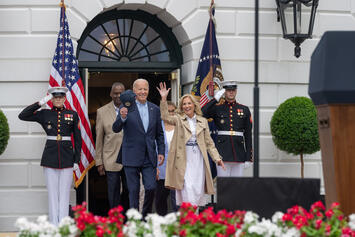
The end of Joe Biden’s presidency also signals the demise of the old Democratic Party, with its roots in liberal ideals and advocacy for ‘the common man’. Although Biden, to his own detriment, chose to adopt the progressive views now dominant in the media and political apparat, he remained, at least superficially, a man of the old Roosevelt-Truman-Kennedy Democrats.
With the ascension of Kamala Harris, the Democrats have made a full break from their historic roots as the party of workers and have gravitated towards the decidedly post-industrial politics of California-style progressives. Rather than worrying primarily about lifting up living standards, the party’s emphasis will now be on issues like climate change, abortion, reparations and trans advocacy.
Arguably the biggest winner will be identity politics. After all, Harris’s career was made possible by both traditional femininity – most evident in her career-boosting affair with a much older man, former California State Assembly speaker Willie Brown – and her identification with feminist causes. Her mixed-race background has been – forgive the expression – her trump card.
It’s highly unlikely that a politician of such modest gifts would have had such a meteoric career if she had been a man or a plain vanilla woman. Clearly, her elevation to vice-president was entirely based on her identity as the product of West Indian and South Asian parents, as well as her XX chromosomes. If elected, she would be America’s first DEI president.
Yet this trajectory also makes Harris a far better fit to the emerging, progressive-dominated Democratic Party than the sclerotic Biden. Lunch-bucket Joe from Scranton, Pennsylvania was never a natural fit in a party dominated by the professional classes, the federal bureaucracy and dependent voters. He was something of an anachronism in an era where the white working class, the supposed homebase of the Bidens, has been shifting inexorably away from the Democrats towards the GOP. This shift began even before Donald Trump, particularly under Richard Nixon and Ronald Reagan.
Now some of the same dynamic is occurring among other ethnic groups, notably Latinos. Minorities make up over 40 per cent of the US working class and by 2032 will constitute its majority. Yet this should not be too comforting to Democrats. Trump was even or ahead of Biden with Latinos long before the debate debacle sealed the president’s fate. That represents a dramatic change. In recent elections, Barack Obama won roughly 70 per cent of the Latino vote.
Historically, Democrats kept these voters by focussing on bread-and-butter issues, like housing, wages, living and working conditions. But today’s Democratic Party base lies elsewhere, with the professional urban elite whose views differ enormously with the vast majority on issues like censorship, or rationing of gas and meat. This new party base, concentrated in a handful of cities, as beneficiaries of both government largesse and the stock market boom, has reason to love the current regime. But working-class people are doing less well. As a result, they are far less supportive of the Democrats in the key battleground states, such as Arizona and Michigan.
Read the rest of this piece at Spiked.
Joel Kotkin is the author of The Coming of Neo-Feudalism: A Warning to the Global Middle Class. He is the Roger Hobbs Presidential Fellow in Urban Futures at Chapman University and and directs the Center for Demographics and Policy there. Learn more at joelkotkin.com and follow him on Twitter @joelkotkin.
Photo: Official White House Photo by Erin Scott via Flickr.












